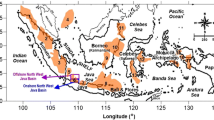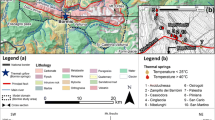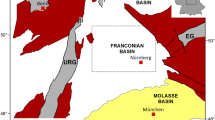Abstract
This study predicts the subsurface temperature distribution of Germany’s capital Berlin. For this purpose, a data-based lithosphere-scale 3D structural model is developed incorporating 21 individual geological units. This model shows a horizontal grid resolution of (500 × 500) m and provides the geometric base for two different approaches of 3D thermal simulations: (1) calculations of the steady-state purely conductive thermal field and (2) simulations of coupled fluid flow and heat transport. The results point out fundamentally different structural and thermal configurations for potential geothermal target units. The top of the Triassic Middle Buntsandstein strongly varies in depth (159–2,470 m below sea level) and predicted temperatures (15–95 °C), mostly because of the complex geometry of the underlying Permian Zechstein salt. The top of the sub-salt Sedimentary Rotliegend is rather flat (2,890–3,785 m below sea level) and reveals temperatures of 85–139 °C. The predicted 70 °C-isotherm is located at depths of about 1,500–2,200 m, cutting the Middle Buntsandstein over large parts of Berlin. The 110 °C-isotherm at 2,900–3,700 m depth widely crosscuts the Sedimentary Rotliegend. Groundwater flow results in subsurface cooling the extent of which is strongly controlled by the geometry and the distribution of the Tertiary Rupelian Clay. The cooling effect is strongest where this clay-rich aquitard is thinnest or missing, thus facilitating deep-reaching forced convective flow. The differences between the purely conductive and coupled models highlight the need for investigations of the complex interrelation of flow- and thermal fields to properly predict temperatures in sedimentary systems.










Similar content being viewed by others

Abbreviations
- c () :
-
Solid or fluid heat capacity (kJ kg−1 K−1)
- D :
-
Thermodispersivity tensor (m2 s−1)
- g :
-
Gravity force (m s−2)
- I :
-
Unit tensor (–)
- k :
-
Permeability tensor of the porous medium (m2)
- p :
-
Pressure (Pa)
- S :
-
Rock radiogenic heat production (μW m−3)
- t :
-
Time (s)
- T :
-
Temperature (°C or K)
- Q () :
-
Fluid and solid mass source-sink term (kg m−3 s−1)
- q :
-
Darcy velocity (m s−1)
- \(\in\) :
-
Porosity, void space fraction (–)
- λ () :
-
Fluid, solid or bulk thermal conductivity (W m−1 K−1)
- ρ () :
-
Fluid or solid density (kg m−3)
- μ :
-
Fluid dynamic viscosity (Pa s)
- \(\nabla\) :
-
Nabla operator [m−1]
- b:
-
Bulk (liquid + solid)
- l:
-
Liquid phase
- s:
-
Solid phase
References
Agemar T, Schellschmidt R, Schulz R (2012) Subsurface temperature distribution in Germany. Geothermics 44:65–77
Balling P, Maystrenko YP, Scheck-Wenderoth M (2013, this issue) The deep thermal field of the Glueckstadt Graben. Environ Earth Sci
Bayer U, Scheck M, Koehler M (1997) Modeling of the 3D thermal field in the Northeast German Basin. Geologische Rundschau (Int J Earth Sci) 86:241–251
Bear J (1979) Hydraulics of groundwater. McGraw-Hill, New York
Benek R, Kramer W, McCann T, Scheck M, Negendank JFW, Korich D, Huebscher HD, Bayer U (1996) Permo-carboniferous magmatism of the Northeast German Basin. Tectonophysics 266:379–404
Berliner Senatsverwaltung für Wirtschaft, Technologie und Frauen (2011) Energiekonzept 2020, Langfassung, Energie für Berlin, Effizient-Erneuerbar-Zukunftsfähig. Berliner Senatsverwaltung für Wirtschaft, Technologie und Frauen
Blackwell DD, Steele JL (1989) Heat flow and thermal potential of Kansas. In: Steeples DW (ed) Geophysics in Kansas, vol 226. Kansas Geological Survey Bulletin, pp 267–295
Blöcher MG, Zimmermann G, Moeck I, Brandt W, Hassanzadegan A, Magri F (2010) 3D numerical modeling of hydrothermal processes during the lifetime of a deep geothermal reservoir. Geofluids 10:406–421
Cacace M, Kaiser BO, Lewerenz B, Scheck-Wenderoth M (2010) Geothermal energy in sedimentary basins: what we can learn from regional numerical models. Chem Erde 70:33–46
Cacace M, Blöcher MG, Watanabe N, Moeck I, Börsing N, Scheck-Wenderoth M, Kolditz O, Huenges E (2013) Modelling of fractured carbonate reservoirs—outline of a novel technique via a case study from the Molasse Basin, southern Bavaria (Germany). Environ Earth Sci. doi:10.1007/s12665-013-2402-3
Cherubini Y, Cacace M, Scheck-Wenderoth M, Moeck I, Lewerenz B (2013) Controls on the deep thermal field—implications from 3D numerical simulations for the geothermal research site Groß Schönebeck. Environ Earth Sci. doi:10.1007/s12665-013-2519-4
Clauser C, Giese P, Huenges E, Kohl T, Lehmann H, Rybach L, Šafanda J, Wilhelm H, Windloff K (1997) The thermal regime of the crystalline continental crust: Implications from the KTB. J Geophys Res 102(B8):18417–18441
Diersch H-J (2009) FEFLOW finite element subsurface flow and transport simulation system, reference manual. WASY GmbH Institute for Water Resources Planning and System Research, Berlin
FIG Commission 3 (2010) Rapid Urbanization and Mega Cities: The Need for Spatial Information Management, Research study by FIG Commission 3. In: Potsiou C (ed) FIG Publication, vol 48. The International Federation of Surveyors (FIG), Copenhagen
Fuchs S, Förster A (2010) Rock thermal conductivity of Mesozoic geothermal aquifers in the Northeast German Basin. Chem Erde 70:13–22
Henning A, Limberg A (2012) Variation of the subsoil temperature field in Berlin as a result of climate change and urbanization. Brandenburgische Geowissenschaftliche Beiträge, Cottbus 19:81–92
Hoth K, Rusbült J, Zagora K, Beer H, Hartmann O (1993) Die tiefen Bohrungen im Zentralabschnitt der Mitteleuropäischen Senke—Dokumentation für den Zeitabschnitt 1962–1990. Gesellschaft für Geowissenschaften Berlin
Huenges E (2010) Geothermal energy systems: exploration, development and utilization. Wiley-VCH, New York
Hurtig E, Rockel W (1992) Federal Republic of Germany Eastern Federal States. In: Cermak V, Heanel R, Zui V, Hurtig E (eds) Geothermal atlas of Europe. Hermann Haack Verlagsgesellschaft mbH, Gotha, pp 38–40
Jaroch A (2006) Stratifizierung des hydrogeologischen 3D Modells von Berlin unter Berücksichtigung qualifizierter Bohrungsinformationen. Unpublished master thesis, Technical University of Berlin
Jensen PK (1990) Analysis of the temperature field around salt diapirs. Geothermics 19:273–283
Kaiser BO, Cacace M, Scheck-Wenderoth M, Lewerenz B (2011) Characterization of main heat transport processes in the Northeast German Basin: constraints from 3-D numerical models. Geochem Geophys Geosyst 12:17
Kastner O, Sippel J, Scheck-Wenderoth M, Huenges E (2013, this issue) The deep geothermal potential of the Berlin area. Environ Earth Sci
Kukkonen IT, Jõeleht A (2003) Weichselian temperatures from geothermal heat flow data. J Geophys Res Solid Earth 108(B3):2163
Kukkonen IT, Šafanda J (1996) Palaeoclimate and structure: the most important factors controlling subsurface temperatures in crystalline rocks. A case history from Outokumpu, eastern Finland. Geophys J Int 126:101–112
LIAG (2009) Geophysics Information System. http://www.liag-hannover.de/en/research-of-methods-sections/geothermics-information-systems/projects/fis-gp-geophysics-information-system.html
Magri F, Bayer U, Tesmer M, Möller P, Pekdeger A (2008) Salinization problems in the NEGB: results from thermohaline simulations. Int J Earth Sci (Geologische Rundschau) 97
Maystrenko YP, Scheck-Wenderoth M (2013) 3D lithosphere-scale density model of the Central European Basin System and adjacent areas. Tectonophysics in press (accepted manuscript, available online 27 April 2013). doi:10.1016/j.tecto.2013.04.023
Maystrenko Y, Bayer U, Scheck-Wenderoth M (2013) Salt as a 3D element in structural modeling—example from the Central European Basin System. Tectonophysics 591:62–82. doi:10.1016/j.tecto.2012.06.030
Mottaghy D, Pechnig R, Vogt C (2011) The geothermal project Den Haag: 3D numerical models for temperature prediction and reservoir simulation. Geothermics 40:199–210
Nield DA, Bejan A (2006) Convection in porous media. Springer, Berlin
Noack V, Cherubini Y, Scheck-Wenderoth M, Lewerenz B, Höding T, Simon A, Moeck I (2010) Assessment of the present-day thermal field (NE German Basin)—inferences from 3D modelling. Chem Erde 70:47–62
Noack V, Scheck-Wenderoth M, Cacace M (2012) Sensitivity of 3D thermal models to the choice of boundary conditions and thermal properties: a case study for the area of Brandenburg (NE German Basin). Environ Earth Sci 67(6):1695–1711. doi:10.1007/s12665-012-1614-2
Noack V, Scheck-Wenderoth M, Cacace M, Schneider M (2013) Influence of fluid flow on the regional thermal field: results from 3D numerical modelling for the area of Brandenburg (North German Basin). Environ Earth Sci. doi:10.1007/s12665-013-2438-4
Norden B, Förster A (2006) Thermal conductivity and radiogenic heat production of sedimentary and magmatic rocks in the Northeast German Basin. AAPG Bull 90:939–962
Norden B, Förster A, Balling N (2008) Heat flow and lithospheric thermal regime in the Northeast German Basin. Tectonophysics 460:215–229
Norden B, Förster A, Behrends K, Krause K, Stecken L, Meyer R (2012) Geological 3-D model of the larger Altensalzwedel area, Germany, for temperature prognosis and reservoir simulation. Environ Earth Sci 67(2):511–526. doi:10.1007/s12665-012-1709-9
Philipp SL, Parchwitz S, Götz AE (2011) Geothermal Potential of the Upper Muschelkalk in Northeastern Germany. EGU General Assembly, vol 13. EGU2011-2487. EGU 2011, Vienna (Austria)
Pöppelreiter M, Borkhataria R, Aigner T, Pipping K (2005) Production from Muschelkalk carbonates (Triassic, NE Netherlands): unique play or overlooked opportunity? Petroleum Geology Conference Series, vol 6. Geological Society, London, pp 299–315. doi:10.1144/0060299
Rühaak W, Rath V, Clauser C (2010) Detecting thermal anomalies within the Molasse Basin, southern Germany. Hydrogeol J 18:1897–1915
Šafanda J, Rajver D (2001) Signature of the last ice age in the present subsurface temperatures in the Czech Republic and Slovenia. Global Planet Change 29:241–257
Šafanda J, Szewczyk J, Majorowicz J (2004) Geothermal evidence of very low glacial temperatures on a rim of the Fennoscandian ice sheet. Geophys Res Lett 31:L07211
Scheck M, Bayer U (1999) Evolution of the Northeast German Basin—inferences from a 3D structural model and subsidence analysis. Tectonophysics 313:145–169
Scheck M, Bayer U, Lewerenz B (2003) Salt movement in the Northeast German Basin and its relation to major post-Permian tectonic phases—results from 3D structural modelling, backstripping and reflection seismic data. Tectonophysics 361:277–299
Scheck-Wenderoth M, Lamarche J (2005) Crustal memory and basin evolution in the Central European Basin System—new insights from a 3D structural model. Tectonophysics 397:132–165
Schilling O, Sheldon HA, Reid LB, Corbel S (2013) Hydrothermal models of the Perth metropolitan area, Western Australia: implications for geothermal energy. Hydrogeol J 21:605–621
Schütz F, Fuchs S, Förster A, Förster H-J (2013) Facies-related trends of rock thermal conductivity and the impact on temperature prognosis for geothermal target reservoirs General Assembly European Geosciences Union 2013, Vienna, Austria (07-12 April 2013) 2013. Geophysical Research Abstracts 15 (EGU2013-3187)
Stackebrandt W, Manhenke V (2002) Atlas zur Geologie von Brandenburg im Maßstab 1:1000000. Landesamt für Geowissenschaften und Rohstoffe, Kleinmachnow
Wong LW, Watanabe N, Cacace M, Blöcher MG, Kastner O, Zimmermann G (2013, this issue) Sensitivity analysis of permeability and apertures of natural internal fault zones on fluid flow and heat transfer in a deep geothermal reservoir. Environ Earth Sci
Acknowledgments
We would like to thank GTN Geothermie Neubrandenburg, LBGR Brandenburg, Senatsverwaltung Berlin, and GASAG Berlin for their support and for providing diverse data sets including core data and drilling reports. Especially, we would like to acknowledge Berliner Erdgasspeicher GmbH for allocating stratigraphic information from the well E Berlin 1/70. Many thanks go also to Inga Moeck for fruitful discussion on the Berlin subsurface geology and to Christoph Wehner for his technical help in completing this manuscript. This study was co-funded by the European Union in the framework of the Climate Knowledge and Innovation Centre of the European Institute of Technology (EIT Climate-KIC) projects Energy Atlas Berlin and Neighbourhood Demonstraters.
Author information
Authors and Affiliations
Corresponding author
Rights and permissions
About this article
Cite this article
Sippel, J., Fuchs, S., Cacace, M. et al. Deep 3D thermal modelling for the city of Berlin (Germany). Environ Earth Sci 70, 3545–3566 (2013). https://doi.org/10.1007/s12665-013-2679-2
Received:
Accepted:
Published:
Issue Date:
DOI: https://doi.org/10.1007/s12665-013-2679-2



